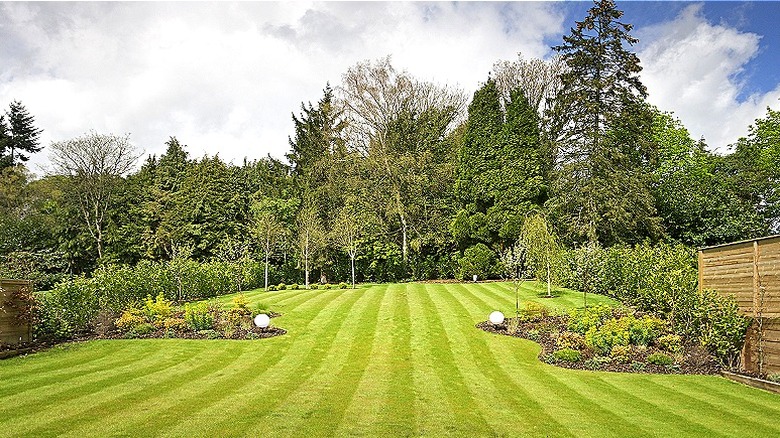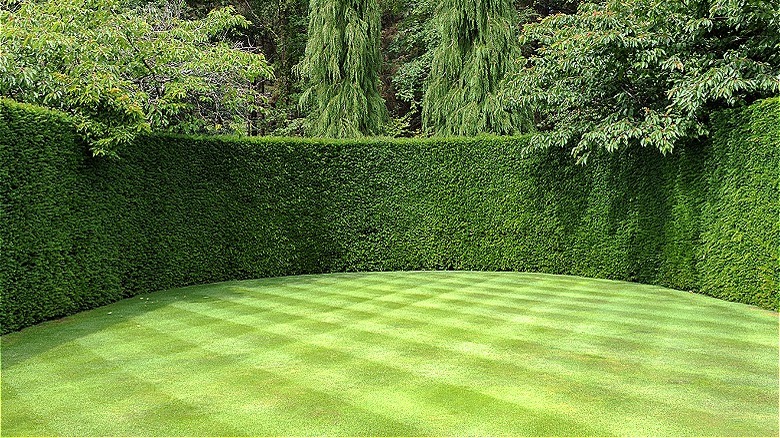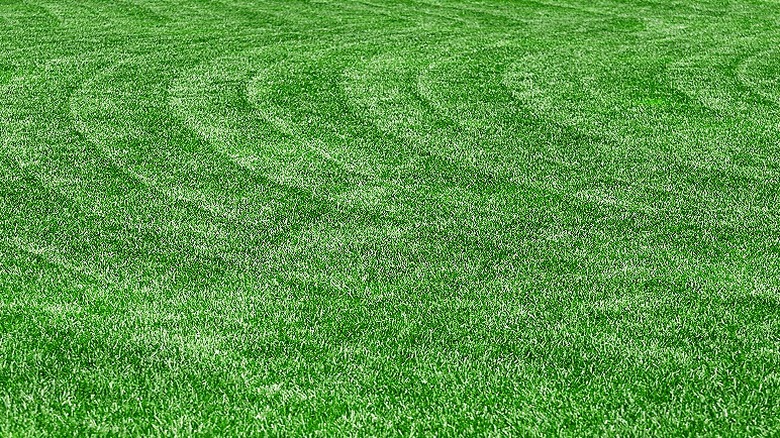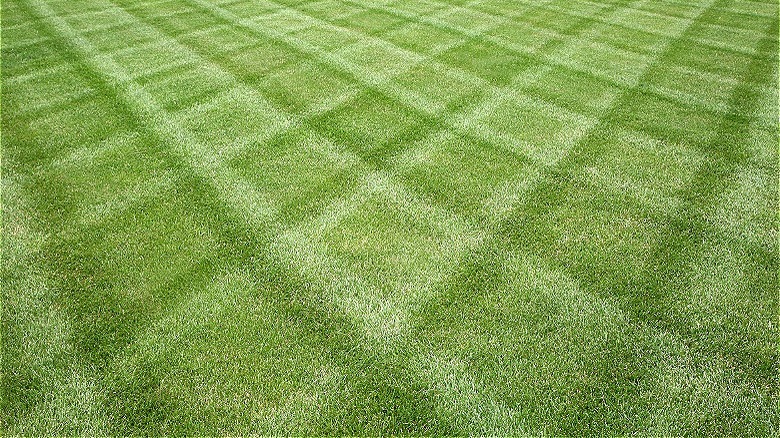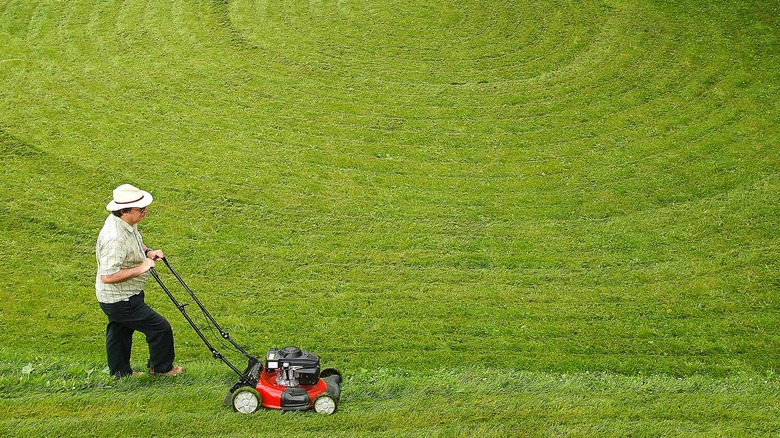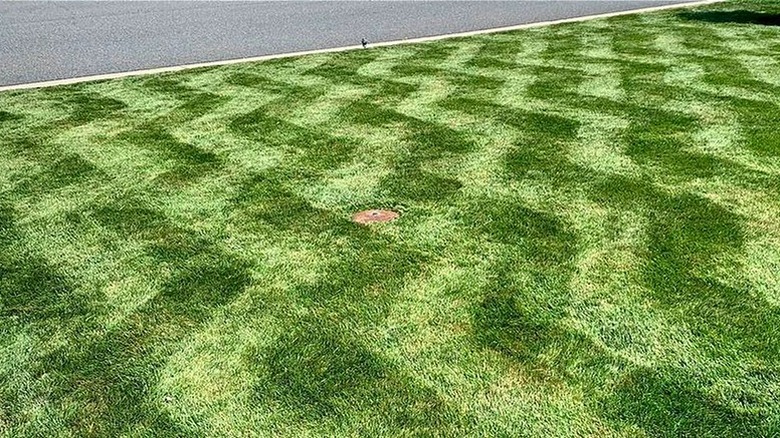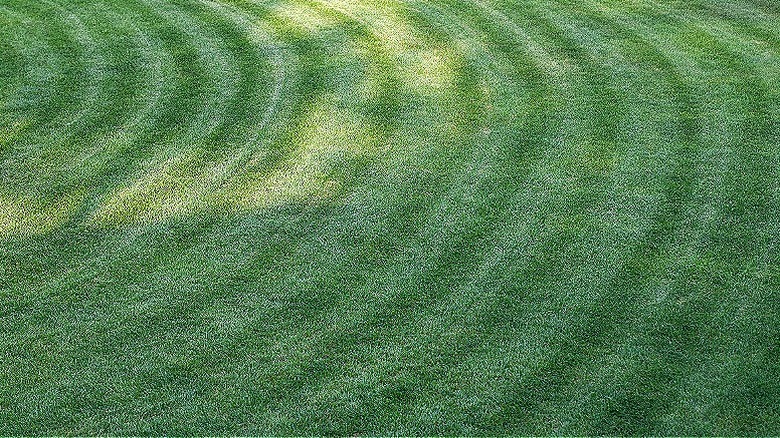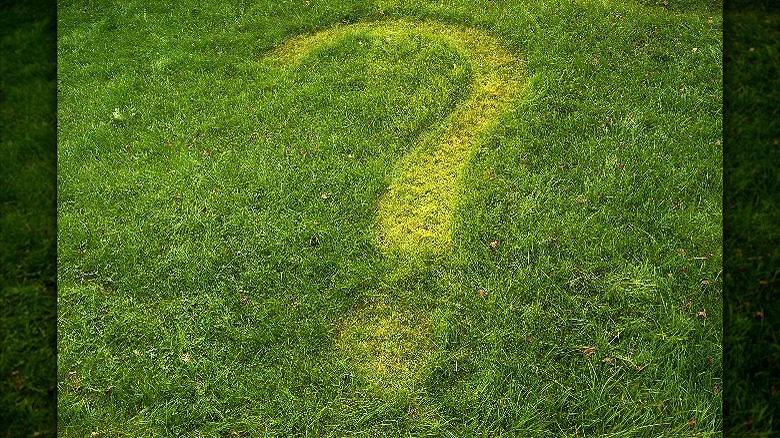How To Get Fancy Mowing Patterns That Your Neighbors Will Envy
Keeping your outdoor spaces well-maintained is a great way to improve the overall appearance of your home, boost your property value, and ensure your grass stays healthy, but the simple chore of mowing the lawn often feels much more like an unwanted workout than a way to express your creativity and have some fun. If you need some inspiration to take this from a dreaded chore to a fun hobby, however, there's one easy way to break out of that mold and make cutting the grass a more enjoyable activity. Instead of speeding through the process on your day off, try your hand at mowing in some fancy lawn patterns.
When you think of lawn-mowing patterns, the first thing that comes to mind is likely million-dollar estates and baseball fields that have a whole team dedicated to keeping the grass in pristine shape. As it turns out, however, etching in a simple pattern is fairly easy to accomplish on your own, and switching up your path regularly can even provide some benefits for your yard in the long run. Once you learn how to create your own mowing patterns, your yard will be the talk of the neighborhood in no time.
Stripes
For those who have never attempted to mow in a design, stripes are a great place to start, as they're the simplest pattern and give you good training for pulling off more complex looks in the future. To begin, mow around the perimeter, then find one edge of your lawn and mow in a straight line, using something straight like a fence or wall as a guide if possible. Turn 180 degrees once you reach the end, and head back the way you came, making sure to overlap your lines slightly. If you're able to keep everything straight, you will be left with a professional-looking lawn with minimal effort.
Checkerboard
To mow in a trendy checkered print, all you really need to do is mow stripes across your lawn twice. Follow the same rules the first time around — follow a straight edge, overlap the path of your mower slightly, and attempt to keep everything as straight as possible. After you finish the entire lawn, turn your mower 90 degrees and repeat the process in the opposite direction. Once you're done, you can also choose to go around the edges in one continuous loop to create a clean border and hide any less-than-pristine marks left from where you had to turn and adjust to head in the opposite direction.
Curves
If you're getting a bit tired of having to keep your lines perfectly straight when mowing stripes, consider going for a curves pattern for a bit more variety. Curves can come about naturally if you're working to avoid an obstacle like a tree or a playhouse, or you can create them artificially for decorative purposes. When you go in to mow your first curve, however, make sure you keep your movements consistent. Once you're happy with the first line, head back in the opposite direction like you would with regular stripes, using the edge of your last pass as a guide to keep everything looking smooth and perfectly wavy.
Diamonds
For a lawn pattern that's quite impressive to passers-by but doesn't require much more effort on your part, consider trying your hand at making diamonds. Diamonds are very similar to a checkerboard pattern — start at the edge, mow stripes in one direction, then switch and mow in the other direction — but instead of turning 90 degrees to complete your second pass, you turn 45 degrees. This design, however, might cause some issues around the edges as you'll likely be approaching the corners of your yard at a slightly awkward angle, but a cleanup pass once you're finished to frame out the design should keep everything looking pristine.
Circles
Switching up the patterns you use to mow your lawn is a great way to keep it looking and feeling healthy, but sometimes, you just can't be bothered to put in that much effort. On the weeks where you'd like to avoid making repeated 90-degree turns or maintaining a perfectly straight line, consider going for a simple circle design. If you have an obstacle in the middle of your lawn to use as a focal point, begin there, then spiral outward. If not, begin from the outside edge of your lawn and work inward. With this method, you won't ever have to stop and change direction.
Zigzags
If you're in the mood for something out of the ordinary, consider going for a zigzag pattern. This option is a bit more involved than other options, but it's a great way to make an impact, especially if you're working with a smaller space. To start, mow a classic checkerboard pattern, then use that as a template to make your zigzags. Move diagonally for however long you want your first length to be, then turn and move the same number of spaces straight. Repeat this in the opposite direction for the next row to ensure your zigzags contrast each other.
Overlapping curves
For something that borders on an optical illusion, consider combining a classic curve with a checkerboard pattern. To create this striking look, mow your lawn in semicircles, switching directions when you reach the edge to create stripes. Once you've completed one side, head to the other and do the same thing with your curves running in the opposite direction, creating a sort of Venn diagram shape. This pattern is a bit difficult to understand at first glance, but, after you get into the rhythm, it is actually fairly simple to pull off, especially if you focus on one step at a time.
Striped circles
If you enjoy the look of a spiral in your lawn but you want a bit more contrast, consider mowing circles like you would stripes. Begin around an obstacle or at the edge of your lawn, then create circles, switching the direction of your mower once you move on to the next layer. The final result will be something that takes about as much effort as a typical stripe pattern, but gives off a more organic, free-flowing look. This is also a great option if you have an obstacle and haven't quite figured out how to work around it with straight lines yet.
Create your own
Once you've figured out the basics of lawn art, you can get to work developing your own mowing patterns. If you're in the mood to get creative, consider sketching out a basic outline of your yard and then plotting out your ideas before jumping right in. Try combining rounder waves and circles with precise stripes, or use the checkerboard technique with different kinds of lines to vary the look. Don't be afraid to try out bolder designs than you're used to seeing around the neighborhood — if you're not a fan of the final product, your yard will likely need another trim in a week or so, anyway.

